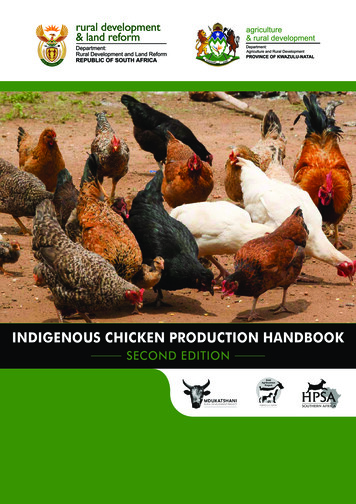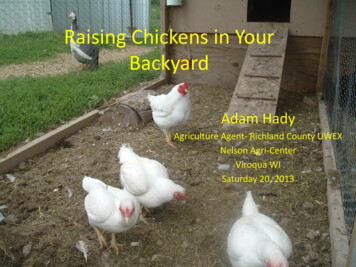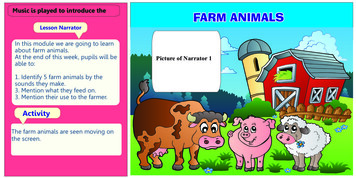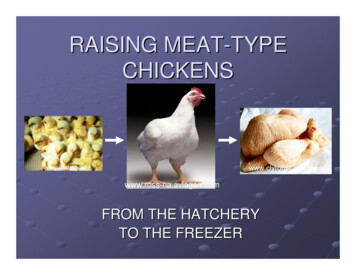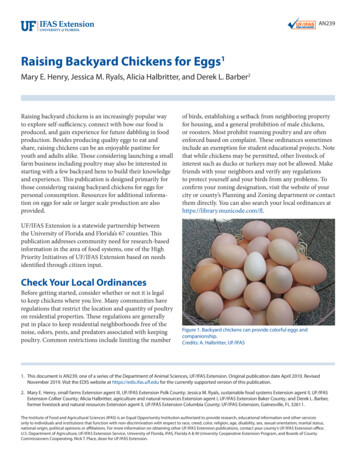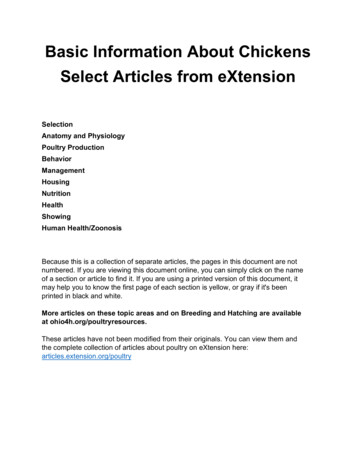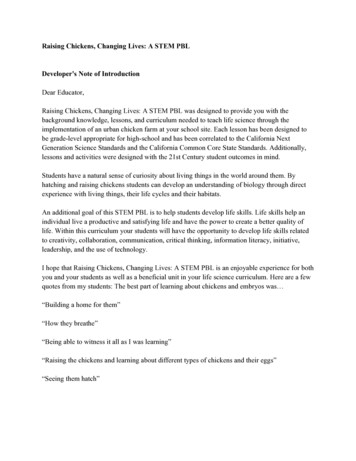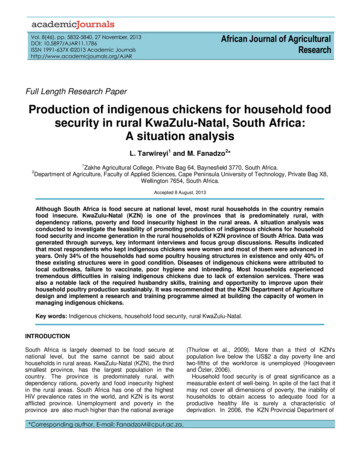
Transcription
African Journal of AgriculturalResearchVol. 8(46), pp. 5832-5840, 27 November, 2013DOI: 10.5897/AJAR11.1786ISSN 1991-637X 2013 Academic Journalshttp://www.academicjournals.org/AJARFull Length Research PaperProduction of indigenous chickens for household foodsecurity in rural KwaZulu-Natal, South Africa:A situation analysisL. Tarwireyi1 and M. Fanadzo2*1Zakhe Agricultural College, Private Bag 64, Baynesfield 3770, South Africa.Department of Agriculture, Faculty of Applied Sciences, Cape Peninsula University of Technology, Private Bag X8,Wellington 7654, South Africa.2Accepted 8 August, 2013Although South Africa is food secure at national level, most rural households in the country remainfood insecure. KwaZulu-Natal (KZN) is one of the provinces that is predominately rural, withdependency rations, poverty and food insecurity highest in the rural areas. A situation analysis wasconducted to investigate the feasibility of promoting production of indigenous chickens for householdfood security and income generation in the rural households of KZN province of South Africa. Data wasgenerated through surveys, key informant interviews and focus group discussions. Results indicatedthat most respondents who kept indigenous chickens were women and most of them were advanced inyears. Only 34% of the households had some poultry housing structures in existence and only 40% ofthese existing structures were in good condition. Diseases of indigenous chickens were attributed tolocal outbreaks, failure to vaccinate, poor hygiene and inbreeding. Most households experiencedtremendous difficulties in raising indigenous chickens due to lack of extension services. There wasalso a notable lack of the required husbandry skills, training and opportunity to improve upon theirhousehold poultry production sustainably. It was recommended that the KZN Department of Agriculturedesign and implement a research and training programme aimed at building the capacity of women inmanaging indigenous chickens.Key words: Indigenous chickens, household food security, rural KwaZulu-Natal.INTRODUCTIONSouth Africa is largely deemed to be food secure atnational level, but the same cannot be said abouthouseholds in rural areas. KwaZulu-Natal (KZN), the thirdsmallest province, has the largest population in thecountry. The province is predominately rural, withdependency rations, poverty and food insecurity highestin the rural areas. South Africa has one of the highestHIV prevalence rates in the world, and KZN is its worstafflicted province. Unemployment and poverty in theprovince are also much higher than the national average*Corresponding author. E-mail: FanadzoM@cput.ac.za.(Thurlow et al., 2009). More than a third of KZN'spopulation live below the US 2 a day poverty line andtwo-fifths of the workforce is unemployed (Hoogeveenand Özler, 2006).Household food security is of great significance as ameasurable extent of well-being. In spite of the fact that itmay not cover all dimensions of poverty, the inability ofhouseholds to obtain access to adequate food for aproductive healthy life is surely a characteristic ofdeprivation. In 2006, the KZN Provincial Department of
Tarwireyi and Fanadzo5833Table 1. Description of study ehloUmziwabantuArea(km 2)9731 089.5Population(2007)Number ofhouseholdsProjects surveyed74 017104 52716 36620 313Msisizane and FaliniHlanganani and OcingweniUmgungundlovuMsunduziRichmond6491 231.3616 73056 772137 73512 679Vukuwenze and ZimiseleniThandukuhle and MasizathembeUmkhanyakhudeUmhlambuyalinganaBig Five False Bay3 6931 161140 96334 99126 6286 657Phaphamani and VukayibambeSiyazama and SiyezaZululandPhongolaDumbe3 2391 942.8149 54375 09622 11215 147Vukayibambe and MasakhaneThandukuzenzela and VukuwenzeSource of figures: Statistics SA (2009).Agriculture in collaboration with the Government ofFlanders unveiled a five-year “Empowerment for FoodSecurity Program” (EFSP) project. The objective of theEFSP project was to improve the livelihoods of poorhouseholds by creating sustainable access to nutritiousfood for all household members in KZN. The main target(beneficiary) groups were farmers, women and peopleliving with HIV/AIDS, especially people facing andexperiencing food insecurity. The program was aimed attraining communities to produce their own food byengaging them in diverse projects. One of these projectswas the promotion of the production of indigenouschickens to improve household food security.Low-input indigenous chicken production is verypopular amongst resource-limited rural communities ofSouth Africa (Mtileni et al., 2009). Indigenous chickensplay many socio-economic roles in traditional religiousand other customs, as gift payments and serve as animportant source of animal protein (McAinsh et al., 2004).They are also considered one of the main sources ofincome for the rural poor (Swatson et al., 2001; 2004;Muchadeyi et al., 2005, 2007; Mtileni et al., 2009).Sonaiya (2003) defined village chickens as involving anygenetic stock, improved or unimproved, that was raisedextensively or semi-intensively in relatively smallnumbers (usually less than 100 at a time). There isconsiderably minimal investment on inputs with most ofthe inputs generated in the homestead; labour isinexpensive as it can be drawn from the family.Indigenous chickens adapt well to different environmentsand can survive on limited feed resources that fluctuate inquality according to seasons (Kingori et al., 2007).According to Nhleko et al. (2003), village chickens areamong the most adaptable domestic animals that cansurvive cold and heat, wet and drought, sheltered incages, unsheltered outside or roosting in trees.Subsistence farmers keep them for household production(meat and eggs) and/or to supplement their income.These farmers want to keep a chicken that can producesufficient meat and eggs, become broody and hatch theirown chickens to make the owner independent in egg andwhite meat production (Grobbelaar et al., 2010).Indigenous chicken production systems are economicallyefficient because although the output from the individualbird is low, the inputs are usually lower. The main aim ofthis study was to investigate the feasibility of promotingproduction of indigenous chickens for household foodsecurity and income generation in the rural areas of theKZN province of South Africa.MATERIALS AND METHODSStudy areaThe study was carried out in eight selected local municipalitieswithin four districts of KZN (Table 1 and Figure 1). The province ofKZN is characterized by diverse climatic conditions due to largevariation in topographical features, such as the altitude that rangesfrom sea level at the shoreline to over 3000 m at the western borderalong the Drakensberg Mountains. Rainfall ranges from 500 mm toover 1500 mm per annum (DEAT, 2000). The coastal region isassociated with humid and warmer temperatures. The four districtsconsist of diverse ecological zones, farming systems and socioeconomic environments. The households visited were subsistencefarmers whose family livelihoods were supported by considerablysmall pieces of semi-arid land.Sampling and data collectionThe size of the survey sample was predominantly determined bythe number of EFSP project participants in the eight localmunicipalities within the four district municipalities. Simple randomsampling was used to select two projects per local municipality fromthe list of existing projects compiled by the KZN Department ofAgriculture. The total number of project members interviewed fromthe 16 projects was 117. All the project members belonging to eachof the selected projects were interviewed. The size and type ofprojects were variable and project membership varied in numbersfrom about 6 to 35. Data on socio-economic characteristics of
5834Afr. J. Agric. Res.Figure 1. Map of KwaZulu-Natal showing the district municipalities from which study areas were ouschickenmanagement systems, problems encountered with the raising ofindigenous chickens and the market opportunities existing for theindigenous chickens were collected using semi-structuredquestionnaires and focus group discussions with members of eachproject. Additional data was generated through key informantinterviews. Key informants were service providers contracted by theKZN Department of Agriculture to implement the EFSP projects in
Tarwireyi and Fanadzo5835Figure 2. Percentage of respondents in the different age groups.Figure 3. Number of participants in the different projects.the different municipalities, agricultural extension agents andcommunity facilitators. Workshops were held with the KZNDepartment of Agriculture extension officers in the respective areasto discuss the objectives and expected outputs from the survey.families (100%) purchased part of their food (up to 65%)to supplement family daily requirements. The numbers ofparticipants in the different projects are shown in Figure 3.Livestock productionRESULTSSocioeconomic characteristics of the respondentsThe majority (77%) of the respondents were females. Theage of the respondents ranged from 19 to 85. The 19-29years age group had the lowest number of respondentswhile the 60 years age group had the highest number ofrespondents (Figure 2). Ninety-seven percent ofhouseholds produced crops to feed their families. AllAbout 77% of households interviewed reared indigenouschickens. Other livestock kept in smaller numbers by therespondents included cattle (7%), goats (4%) and pigs(1%). Members of only three of the sixteen projects keptpigs and the average number was between one and twoper household. The average number of indigenouschickens, cattle and goats kept by projects members ispresented in Figure 4. Indigenous chickens were mainlykept for subsistence and selling would only be done in
5836Afr. J. Agric. Res.Figure 4. Type and average number of livestock reared.OvamboPotchefstroom KoekoekNaked neckFigure 5. Breeds of chickens kept by rural households in KwaZulu-Natal.cases where there was excess or when farmers neededto generate income in form of cash. A minority part of therespondents (21%) indicated that they had receivedformal training in small livestock production.Breeds of indigenous chickens kept and reasons forkeeping themProject participants kept one or more of three breeds;Ovambo, Potchefstroom Koekoek and naked neckchickens (Figure 5). The Ovambo breed was the mostpopular, with an average of 81% of all the respondentskeeping this breed. The least popular was the neckedneck, kept by an average of 3% of all respondents. In twolocal municipalities, Umziwabantu and Msunduzi, none ofthe respondents kept this breed (Figure 6). Table 2shows that all projects visited cited meat as amotivational factor for rearing indigenous chickens.Eleven of the 16 project beneficiaries (69%) cited that, inaddition to meat, they reared indigenous chickens toperform cultural ritual rites and the Ovambo breed wasnoted as important and suitable for this purpose due to itsdark feather colour. Half of the project respondents
Tarwireyi and Fanadzo5837Figure 6. Respondents keeping the different breeds of indigenous chickens.Table 2. Reasons for keeping indigenous chickens.Project niVukuwenzeZimiseleniTotal projectsEgg production xx xxx xxxx7Meat 16expressed interest in commercialising indigenous chickenproduction.Selling x xx x xxxx8Manure X xxxxxxxxxxxx3Traditional ceremonies xxxx x 11houses, brooding baskets, mud houses and tin houses. Itwas apparent that the majority of households (66%) couldnot provide decent housing for their chickens and treesplayed an important role in sheltering these birds.Housing for indigenous chickensOnly 34% of the households visited had some poultryhousing structures in existence and only 40% of theseexisting structures were in good condition. Commonmodels used included the A-frame, traditional raisedDisease occurrence in indigenous chickensFigure 7 shows the occurrences of certain poultrydiseases as stated by households interviewed per study
5838Afr. J. Agric. Res.Figure 7. Types and occurrence of diseases in the different projects surveyed.area. Many causes of these diseases were attributed tolocal outbreaks, failure to vaccinate, poor hygiene andinbreeding.therefore be used for compost making, garden manure oras feed for livestock.DISCUSSIONMarket opportunities for commercial productionThe products that could be marketed were meat andeggs. It was apparent that eggs could be produced andmarketed profitably in only two local municipal areasnamely Richmond and Umhlabuyalingana. About 80% ofthe respondents indicated that live chickens could notcompete with the commercial breeds in the market placeas most people regard them as of poor quality.GeneralInterviews with key informants unearthed the followingfacts about indigenous chickens:(i) Meat and eggs of indigenous chickens are tastier andpreferred by some consumers compared to those sold bycommercial producers (broilers),(ii) Initial investment is less than that required to keepcommercial breeds,(iii) Indigenous chickens are more tolerant to harshconditions, including diseases compared to commercialbreeds,(iv) Indigenous chickens can be fed on cheap, locallyavailable feeds,(v) Markets are locally available and there are notransport costs involved,(vi) Chicken droppings are rich in nutrients and canThe dominance of women in smallholder farming, andproduction of indigenous chickens in particular, as foundin this study is a common characteristic, both in SouthAfrica and in most developing countries (Guèye, 2000;Sonaiya, 2005; Doss, 2011; FAO, 2011; Halima et al.,2007). Despite this, extension provision in developingcountries remains low for both women and men, andwomen tend to make less use than men of extensionservices (Meinzen-Dick et al., 2010). There is therefore aneed to design training programmes in indigenouschickens that specifically target women who are the mainplayers.The situation analysis results showed that 56% ofrespondents were 50 years or older. According to Dlovaet al. (2004), age is one of the factors that can affect theprobability of a farmer being successful in farming.Results from their study concluded that older farmerswere less capable of carrying out physical activitiescompared to the younger ones. Dlova et al. (2004)concluded that younger farmers are more ready to adoptmodern technology. Thus, because younger people maybe more adaptive and more willing than older people totry new methods, age is expected to be an influencingfactor. Bembridge (1984) also concluded that as farmersget older, they often become more conservative andreluctant to accept risk, they work fewer hours and havefewer non-farm employment opportunities.The Ovambo chickens were the most popular because
Tarwireyi and Fanadzoof some of their desirable characteristics, in addition touse in traditional ceremonies. The Ovambo chickencombines two characteristics of dark feathers and smallsize which help to camouflage the bird and protect it fromraptors. In addition, the Ovambo is very aggressive andagile, and can fly and roosts in the top of trees to avoidpredators (ARC, 2011). This makes it desirable tofarmers as farmers do not have to worry much aboutinvesting in decent shelter for the birds. This wasconfirmed by the results that showed that only 34% of thehouseholds had some poultry housing structures inexistence and only 40% of these existing structures werein good condition.Despite the unpopularity of the naked-necked chickens,this breed is popular in other parts of the world. Forinstance, in France, the naked neck factor is used toadvantage in commercial production for three reasons.Firstly, a considerable amount of dietary protein is usedin the growing of feathers. The naked necked chickenshave 30% less feathers than fully feathered birds and cantherefore produce the same body weight with less food.Secondly, there are fewer feathers to remove in theslaughter line and therefore they pass through muchfaster and, lastly, they are more heat tolerant (ARC,2011).It is apparent from the findings that the main reason forkeeping indigenous chickens was for meat. Fourie et al.(2004) reported that, because less fat is accumulated incarcasses of indigenous chickens compared tocommercial hybrids, it is healthier to consume indigenouschicken skin as it contains six times less fat than that ofbroiler skin. They also found that the protein content ofindigenous poultry meat was significantly higher incomparison to the meat of broilers and this was likelyattributed to the difference in age at slaughtering. Giventhe nutritional and health advantages of indigenouschickens, promotion of the production of these birds canhelp to increase the life span of many HIV-infectedpeople in rural KZN.Findings of this situation analysis are consistent withfindings by Musharaf (1990) who reported that in manycountries in sub-Saharan Africa, indigenous chickens arecharacterised by low productivity due to poor nutrition,prevalence of disease and lack of sound management.As Dessie (1996) indicated, the nutrient intake of thesechickens from the scavenging resource base is mostlysufficient for maintenance and low production, but forincreased production, additional inputs are required.Indigenous chickens normally have lower growth rate andmature body weights, but with protein supplementation,they might attain similar growth rate and mature bodyweights as commercial chickens (Kingori et al., 2007).ConclusionsFindings of the situation analysis have indicated thatindigenous chickens play an integral role in the5839livelihoods of rural families in KZN. Nevertheless, mosthouseholds are experiencing tremendous difficulties inraising indigenous chickens due to lack of extensionservices. Factors constraining production of indigenouschickens included disease, predation, poor housing, poornutrition and the lack of genetic improvementprogrammes for the indigenous chicken stock. There wasalso a notable lack of the required husbandry skills,training and opportunity to improve upon their householdpoultry production sustainably. This calls for a need tofocus on building the capacity of women through trainingand support services as they are playing a dominant rolein production and management of indigenous chickens.This can be achieved through designing andimplementing a research and training programme aimedat improving the management of indigenous chickens.The programme could include the collection,conservation and improvement of the currents indigenouschicken breeds.ACKNOWLEDGEMENTThis study was co-funded by the KwaZulu-NatalDepartment of Agriculture (South Africa) and theGovernment of Flanders.REFERENCESARC (2011). The indigenous poultry breeds of SA. [Online]. Availableat:http://www.arc.agric.za/home.asp?pid 2706[Dateofaccess:26/09/2011].Bembridge TJ (1984). A Systems Approach Study of Agriculturaldevelopment problems in Transkei. PhD Thesis, University ofStellenbosch, South Africa.DEAT (2000). Department of Environmental Affairs and Tourism.Environmental atlas for KwaZulu-Natal: Mean annual onment.gov.za/enviroinfo/prov/rain.htm. [Date of access: 09/05/2011].Dessie T (1996). Energy and protein requirements of the growingindigenous chickens of Kenya. MSc Thesis, Egerton University,Nigeria.Dlova MR, Fraser GCG, Belete A (2004). Factors affecting the successof farmers in the Hertzog Agricultural Cooperative in the centralEastern Cape (South Africa). Fort Hare 13:21-33.Doss S (2011). If women hold up half the sky, how much of the world’sfood do they produce? ESA Working Paper No. 11-04. The Food andAgriculture Organization of the United Nations. [Online]. Available df[Dateofaccess: 26/09/2011].FAO (2011). The state of food and agriculture: 2010-11. Food andAgriculture Organization of the United Nations Report, Rome, Italy.Fourie HJ, Swatson HK, Grobbelaar JAN, Molalakgotla MN, Joosten papers/2004/30fowls1742.pdf [Date of access: 27/09/2011].Guèye EF (2000). The role of family poultry in poverty alleviation, foodsecurity and the promotion of gender equality in rural Africa. Outlookon Agriculture 29(2):129-136.Grobbelaar JAN, Sutherland B, Molalakgotla NM (2010). Eggproduction potentials of certain indigenous chicken breeds fromSouth Africa. Anim. Genet. Resour. 46:25-32.Halima H, Neser FWC, Van Marle-Koster E (2007). Village-based
5840Afr. J. Agric. Res.indigenous chicken production system in north-west Ethiopia. Trop.Anim. Health Prod. 39:189-197.Hoogeveen J, Özler B (2006). Poverty and Inequality in Post-ApartheidSouth Africa: 1995-2000. In: Bhorat H, Kanbur R (Eds.). Poverty andPolicy in Post-Apartheid South Africa. Human Sciences ResearchCouncil (HSRC) Press, Pretoria, South Africa.Kingori AM, Tuitoek JK, Muiruri HK, Wachira AM, Birech EK (2007).Protein intake of growing indigenous chickens on free-range and theirresponse to supplementation. Int. J. Poult. Sci. 6(9):617-621.McAinsh CV, Kusina J, Madsen J, Nyoni O (2004). Traditional chickenproduction in Zimbabwe. Worlds Poult. Sci. J. 60:233-246.Meinzen-Dick R, Quisumbing A, Behrman J, Biermayr-Jenzano P,Wilde V, Noordeloos M, Ragasa C, Beintema N (2010). Engenderingagricultural research. IFPRI Discussion P. 973, Washington DC.Muchadeyi FC, Sibanda S, Kusina NT, Kusina J, Makuza SM (2005).Village chicken flock dynamics and the contribution of chickens tohousehold livelihoods in a smallholder farming area in Zimbabwe.Trop. Anim. Health Prod. 37:333-344.Muchadeyi FC, Wollny CBA, Eding H, Weigend S, Makuza SM,Simianer H (2007). Variation in village chicken production systemsamong agro-ecological zones of Zimbabwe. Trop. Anim. Health Prod.39:453-461.Musharaf AN (1990). Rural poultry production in Sudan. In: Proceedingsof an International Workshop on Rural Poultry Development in Africa,Obafemi Awolowo University, Nigeria.Mtileni BJ, Muchadeyi FC, Maiwashe A, Phitsane PM, Halimani TE,Chimonyo M, Dzama K (2009). Characterisation of productionsystems for indigenous chicken genetic resources of South Africa.Appl. Anim. Husb. Rural Dev. 2:18-22.Nhleko MJ, Slippers SC, Lubout PC, Nsahlai IV (2003).Characterisation of the traditional poultry production in the ruralagricultural system of Kwazulu-Natal. Paper presented at the 1stNational Workshop on Indigenous Poultry Development, Nature andDevelopment Group of Africa (NGO Registration pp. 026-851-NPO).Sonaiya EB (2003). Backyard poultry production for socio-economicadvancement of the Nigeria family: Requirement for Research andDevelopment. Poult. Sci. J. 1:88-107.Sonaiya EB (2005). Fifteen years of family poultry research anddevelopment at Obafemi Awolowo University, Nigeria. In: RG Alders,PB Spradbrow, MP Young (Eds.). Village chickens, povertyalleviation and the sustainable control of Newcastle diseaseProceedings of an international conference held in Dar es Salaam,Tanzania, 5–7 October 2005.Swatson HK, Nsahlai IV Byebwa BK (2001). The status of smallholderpoultry production in the Alfred District of KZN (South Africa):priorities for intervention. Proceedings of the institutions for TropicalVeterinary Medicine, 10th International conference on “livestock,community and environment”, 20–23 August 2001, Copenhagen,Denmark.Swatson HK, Tshovhote J, Nesamvumi E, Ranwedzi NE, Fourie C(2004). Characterization of indigenous free-ranging poultryproduction systems under traditional management conditions in theVhembe District of the Limpopo Province, South Africa. .pdf [Date of access: 27/09/2011].Statistics SA (2009). Community Survey 2007 Basic Results - KwaZuluNatal. Pretoria, South Africa.Thurlow J, Gow J, George G (2009). HIV/AIDS, growth and poverty inKwaZulu-Natal and South Africa: an integrated survey, demographicand economy-wide analysis. J. Int. AIDS Soc. pp. 12-18.
management systems, problems encountered with the raising of indigenous chickens and the market opportunities existing for the indigenous chickens were collected using semi-structured questionnaires and focus group discussions with members of each project. Additi
